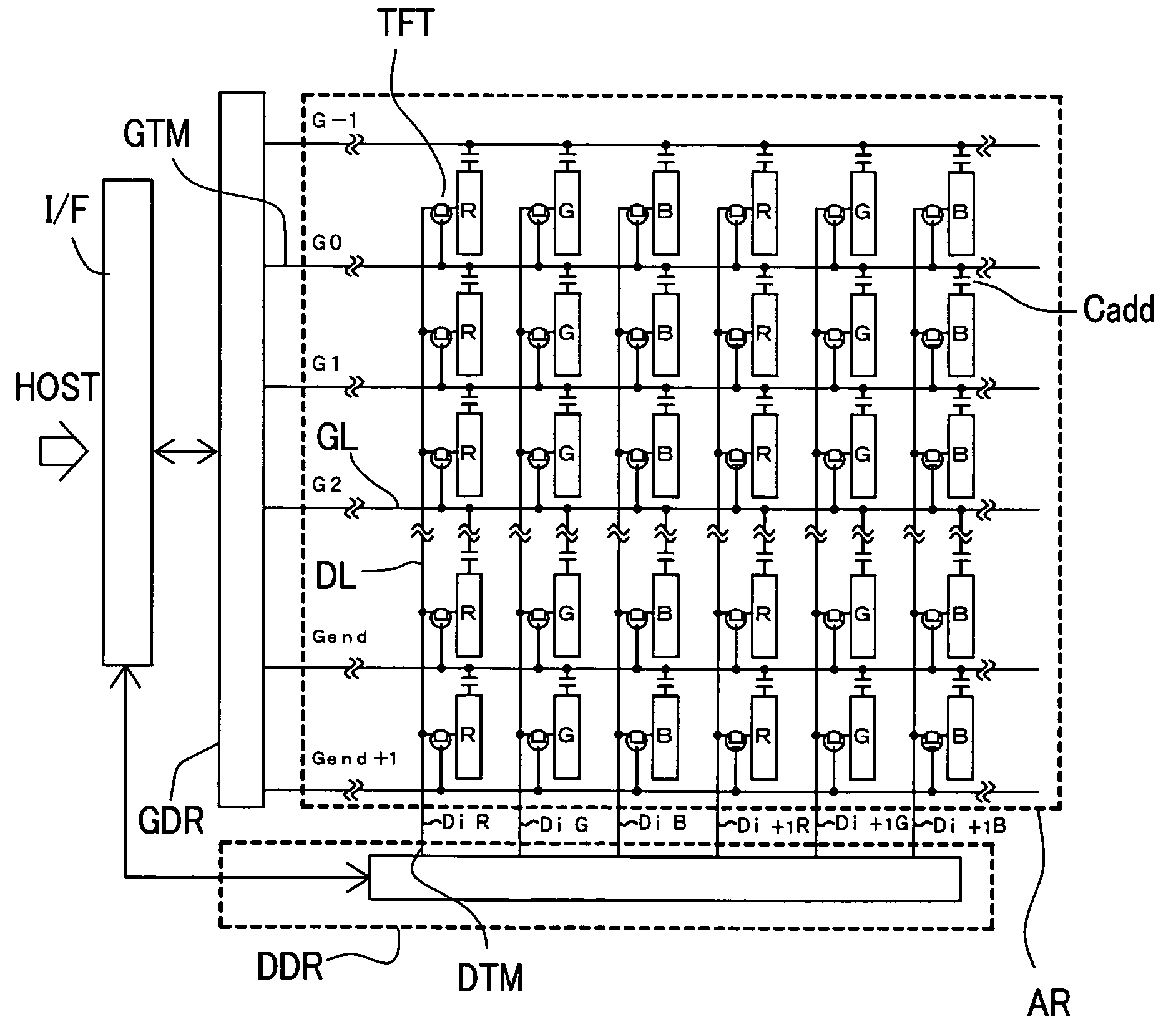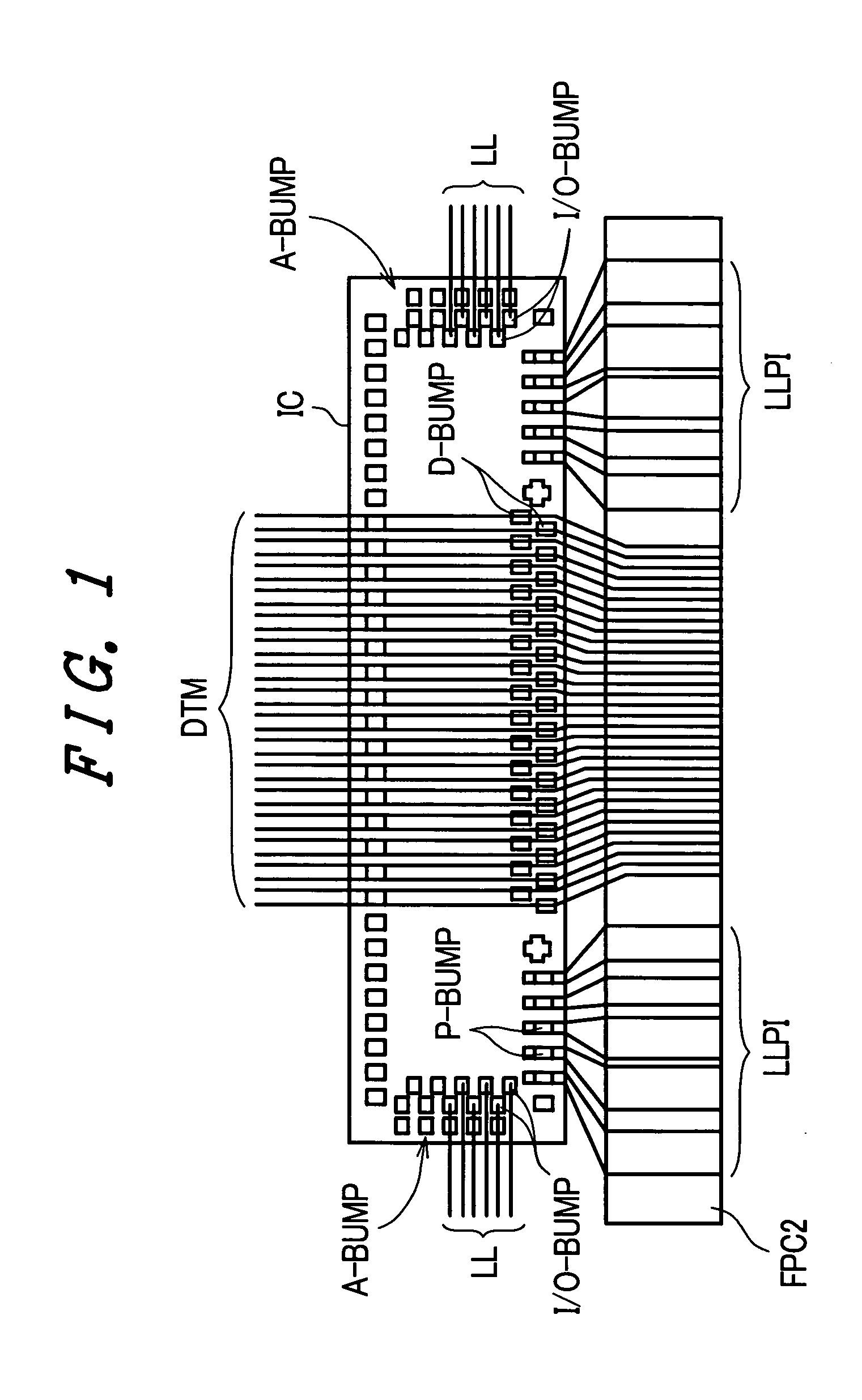Display device
a display device and circuit chip technology, applied in static indicating devices, identification means, instruments, etc., can solve the problems of high connection resistance between bumps and wiring line terminals, unstable, unstable, etc., to reduce the electric resistance, reduce power loss, and reduce the effect of terminal portions
- Summary
- Abstract
- Description
- Claims
- Application Information
AI Technical Summary
Benefits of technology
Problems solved by technology
Method used
Image
Examples
embodiment 1
[0051]FIG. 1 is a plan view showing an example of the structure around a drive circuit chip (an integrated circuit element referred to as a drive circuit element) according to this embodiment, which drive circuit chip is mounted on an end periphery of a main surface of one substrate of a liquid crystal display panel, wherein the drawing shows a state in which a flexible printed circuit board is mounted on the wiring line for inputting drive circuit power. The drive circuit chip IC of this embodiment is used for driving drain lines which supply display data to drains of thin film transistors which constitute pixels. The drive circuit chip IC includes a plurality of first input / output bumps I / O-BUMP and a plurality of second input / output bumps A-BUMP on both short-sides of a mounting surface (a surface facing the insulation substrate, also referred to as a circuit surface or a front-side surface). Further, on one of the long sides which are positioned at an outer periphery of the insu...
embodiment 2
[0068]FIG. 3 is a partially enlarged plan view showing the constitution of the input / output wiring lines LL at the left short side and the first input / output bump and the second input / output bump provided to the drive circuit chip IC. The line EGL shown in FIG. 3 indicates a chip end of the drive circuit chip IC in the same manner as FIG. 2A. In this embodiment, out of the LCD terminals LLT which are alternately arranged, the LCD terminals LLT of the input / output wiring lines LL close to the chip end EGL side of the drive circuit chip IC are enlarged toward the chip end EGL side of the drive circuit chip IC. The width of the LCD terminal LLT in the direction parallel to the chip end EGL is set to a size (a size to cover, the term used in this meaning hereinafter) which includes first input / output bumps I / O-BUMP, wherein the length in the direction perpendicular to the chip end EGL is a size which includes the first input / output bumps I / O-BUMP and the second input / output bump A-BUMP....
embodiment 3
[0072]FIG. 4 is a partially enlarged plan view showing the constitution of the input / output wiring lines LL at the left short side in FIG. 1 and the first input / output bump and the second input / output bump provided to the drive circuit chip IC. This embodiment is characterized in that the second input / output bump A′-BUMP in the embodiment 2 has the same shape as the first input / output bump A-BUMP. In this embodiment, out of the LCD terminals LLT which are alternately arranged, the LCD terminals LLT of the input / output wiring lines LL close to the chip end EGL side of the drive circuit chip IC are enlarged toward the chip end EGL side of the drive circuit chip IC and are connected such that the LCD terminal LLT includes the first input / output bump I / O-BUMP and the second input / output bump A′-BUMP. The other features of this embodiment are substantially equal to the corresponding constitutions of the embodiment 2. Also, according to this embodiment, the previously-mentioned residual s...
PUM
 Login to View More
Login to View More Abstract
Description
Claims
Application Information
 Login to View More
Login to View More - R&D
- Intellectual Property
- Life Sciences
- Materials
- Tech Scout
- Unparalleled Data Quality
- Higher Quality Content
- 60% Fewer Hallucinations
Browse by: Latest US Patents, China's latest patents, Technical Efficacy Thesaurus, Application Domain, Technology Topic, Popular Technical Reports.
© 2025 PatSnap. All rights reserved.Legal|Privacy policy|Modern Slavery Act Transparency Statement|Sitemap|About US| Contact US: help@patsnap.com



